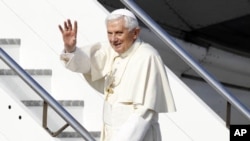Pope Benedict XVI embarks on a trip to Mexico and Cuba March 23. It will be the German-born pontiff's first visit to Spanish-speaking countries in Latin America. The two countries he is visiting have very different religious landscapes.
Security heightened
The Roman Catholic leader, 84 is avoiding the high altitude of Mexico City, on the advice of Vatican doctors, and will begin his trip in Guanajuato, several hundred kilometers from the capital. Thousands of security forces will be deployed amid concerns about safety in a country plagued by drug violence.
After Mexico, Benedict will travel to Cuba's second city, Santiago. He is officially making the trip to honor the national devotion to Our Lady of Charity of Cuba, and to commemorate the miraculous discovery of a statue of the national patroness 400 years ago.
"The pope himself has said that he's coming as a pilgrim of charity, obviously to accompany the people of Cuba during this great time for them," said Rev. Juan Molina, who will accompany the pope in Cuba. Molina is director of the Latin America office at the U.S. Conference of Catholic Bishops in Washington.
Previous visits
Benedict's predecessor, Pope John Paul II, visited Cuba in 1998, but the country has changed since then, with some increase in religious freedom and economic reforms. Georgetown University theology professor Chester Gillis notes the differences in Benedict's and John Paul's pontifical styles.
"John Paul II was such a media darling, and so charismatic," Gillis noted. "And Benedict XVI is not. He is a great intellectual, a deeply spiritual man."
John Paul visited Mexico five times and is revered there. Mexico is Latin America's largest Spanish-speaking Roman Catholic country, but like other countries in the region, the church there is losing adherents to pentecostal and other evangelical Protestant churches.
Gillis says the Vatican is concerned about the problem, "because that seepage has hurt the church. Latin America is still very heavily Roman Catholic, but there are places where there have been significant defections from Catholicism." In some countries more than a quarter of the population is now Protestant.
Church and state
An estimated 10 percent of Cubans are practicing Roman Catholics, and since the communist government relaxed restrictions in the 1990s, the church has gained influence. President Raul Castro's attitude is different than his brother Fidel's, says Philip Peters, a Cuba analyst at the Lexington Institute in Arlington, Virginia.
"A big difference between the relationship between the Catholic Church now and before is that Raul Castro has a direct dialogue with the Catholic Church. Fidel Castro didn't," the analyst says. "Fidel Castro tended to talk over the heads of the Cuban bishops to the Vatican."
The Roman Catholic cardinal in Havana, Jaime Ortega, has met repeatedly with Raul Castro, speaking in favor of economic reforms. In addition, the church negotiated a deal last year that freed the last 75 prisoners held by Cuba on political charges.
News
Pope Prepares For Visit to Mexico, Cuba







